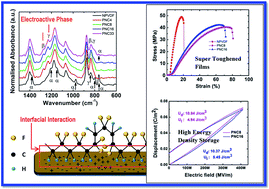Electro-active phase formation in PVDF–BiVO4 flexible nanocomposite films for high energy density storage application†
Abstract
In this work we report on the preparation of polymer nanocomposite (PNC) films, consisting of poly(vinylidene fluoride) and bismuth vanadium oxide nanoparticles (BiVO4-NPs), and its electroactive phase (β- and γ-phase) formation. It was found that BiVO4-NPs can yield up to 98% of the electroactive phases in PVDF. Fourier transform infrared spectroscopy (FTIR) results reveal that electrostatic interactions are present at the interface between surface charges of BiVO4-NPs and –CH2/CF2– molecular dipoles of PVDF favoring and stabilizing the electroactive phases. The electrostatic interaction is further confirmed by X-ray photoelectron spectroscopy (XPS) analysis. Compared to the neat PVDF film, a significantly increased dielectric constant (ε ∼ 44) and a low loss factor (tan δ ∼ 0.02) were observed in the PNC films. In addition, PNC films exhibit a high electrical energy density up to 11 J cm−3 with a breakdown electric field higher than 400 MV m−1. Furthermore, a dramatic improvement of the toughness (460%) was also noticed for the PNC films. These results underline the high potential of such films for their use as flexible high energy density capacitors and flexible piezoelectric based power sources as well.


 Please wait while we load your content...
Please wait while we load your content...